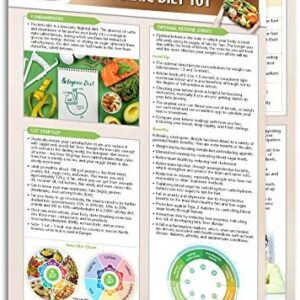This post may contain affiliate links which means I may receive a commission for purchases made through links. Learn more on my Private Policy page.



Price: $8.95
(as of Apr 12, 2023 11:05:28 UTC – Details)

Keto 101 for Beginners: A Comprehensive Guide to the Low-Carb High-Fat Diet
Are you looking for an effective way to lose weight, improve your health, and boost your energy levels? Look no further than the ketogenic diet! This low-carb high-fat approach to eating has helped millions of people achieve their fitness goals and feel their best. In this article, we’ll provide you with a comprehensive guide to keto for beginners, including everything you need to know to get started on this exciting journey.
What is the ketogenic diet and how does it work?
The ketogenic diet, also known as keto, is a high-fat, moderate-protein, and low-carbohydrate diet. By drastically reducing your carbohydrate intake and replacing it with healthy fats, your body enters a state of ketosis, where it begins to burn fat for fuel instead of glucose.
In ketosis, your liver produces ketones, which are used by your brain and other organs for energy. This metabolic state offers numerous benefits, including weight loss, decreased inflammation, improved cognitive function, and more.
What foods can you eat on keto?
To follow the ketogenic diet, you’ll need to focus on healthy sources of fat, protein, and fiber-rich vegetables. Some of the best keto-friendly foods include:
– Avocado and avocado oil
– Coconut oil and MCT oil
– Grass-fed beef, chicken, and pork
– Wild-caught fish and seafood
– Leafy greens, such as spinach and kale
– Cruciferous vegetables, such as broccoli and cauliflower
– Nuts and seeds, such as almonds and chia seeds
– Berries, such as strawberries and raspberries
It’s important to avoid high-carb foods, such as grains, sugar, and processed snacks, which can kick you out of ketosis and limit the benefits of the diet.
How do you get started on keto?
If you’re new to keto, it’s important to take things slow and make gradual changes to your diet. Here are some tips to help you get started:
– Calculate your macronutrient goals: To enter ketosis, you’ll need to consume around 75% of your calories from fat, 20% from protein, and 5% from carbohydrates.
– Stock your pantry: Fill your kitchen with healthy fats, such as avocado oil, coconut oil, and grass-fed butter, as well as protein-rich foods, like chicken, eggs, and nuts.
– Meal plan: Plan out your meals for the week, making sure to include plenty of healthy fats and vegetables. Consider using a meal delivery service or hiring a personal chef to help make meal prep easier.
– Stay hydrated: Drinking plenty of water is essential on keto, as it can help flush out excess ketones and reduce the risk of dehydration.
– Track your progress: Use a food journal or tracking app to monitor your macronutrient intake and assess your progress over time.
What are some common misconceptions about keto?
Although the ketogenic diet has been shown to be safe and effective for many people, there are still some misconceptions and myths surrounding this approach to eating. Here are some common misunderstandings about keto:
– Keto is a high-protein diet: While it’s true that you need to consume a moderate amount of protein on keto, consuming too much can actually kick you out of ketosis and limit the benefits of the diet.
– Keto is a short-term fix: While some people use keto as a short-term weight loss hack, it can be a sustainable way of eating for many people.
– All fats are created equal: On keto, it’s important to focus on healthy sources of fat, such as avocado, olive oil, and nuts, while avoiding processed and unhealthy fats, such as trans and hydrogenated fats.
– You can’t exercise on keto: This is a common misconception, as it’s possible to exercise and build muscle on keto. However, it’s important to remember that your athletic performance may be affected during the first few weeks of the diet as your body adjusts.
FAQs
1. Can I eat fruit on keto?
While most fruits are high in carbs and sugar, some berries, such as strawberries and raspberries, can be consumed in moderation on keto.
2. Is keto safe for people with diabetes?
Keto has been shown to help improve insulin sensitivity and blood sugar control in people with diabetes. However, it’s important to consult with your doctor before starting any new diet.
3. What kind of exercise should I do on keto?
Any form of exercise is beneficial on keto, but low-intensity activities, such as walking and cycling, may be more sustainable during the first few weeks of the diet.
4. What are some common side effects of keto?
Some people may experience side effects, such as headaches, constipation, and fatigue, during the first few weeks of the diet. These symptoms typically subside as your body enters ketosis.
5. Can I have cheat days on keto?
While some people may choose to have cheat days or meals on keto, it can make it more difficult to maintain ketosis and achieve your goals. Consider finding keto-friendly alternatives to your favorite high-carb foods instead.
In conclusion, keto can be an effective and sustainable way of eating for many people. By focusing on healthy fats and reducing your carbohydrate intake, you can enter a state of ketosis and begin reaping the many benefits of this approach to nutrition. With a bit of patience, planning, and commitment, you can achieve your fitness goals and feel your best on keto.

